|
Signs Along the Way
by Bob Brooke
Today, Americans are aware of litter along their highways and byways—and
that includes a multitude of signs along the way. In recent years,
Americans have made an effort to rid their highways of unsightly
distractions. But in the earlier days of automobiles from the beginning
to mid-20th century, signs of every sort advertising every imaginable
product, convenience, and service that an interstate traveler could
desire bombarded drivers as they rode along.
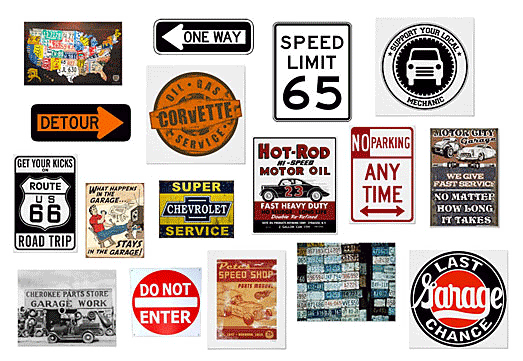
Now these signs have become highly collectible. When it comes to icons
of the open road, few objects convey wanderlust better than those
black-and-white, shield-shaped porcelain signs with the word “Route” at
the top and the number below.
Burma-Shave launched its famous and successful roadside advertising
campaign on Route 66 and countless other byways in 1927. Between that
year and 1963, the shaving-cream company posted some 600 jingles, each
of which unfolded as motorists whizzed past a half-dozen or so
sequential wooden, rectangular signs, which just about always ended with
the brand’s name.
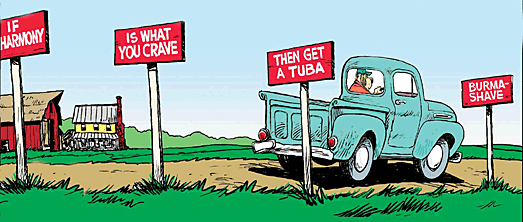
The signs, painted red with white letters, spelled out catchy jingles.
In the early years of the campaign, the company’s messaging to drivers
was fairly straightforward: “Bargain hunters/Gather round/Fifty
cents/Buys/Half a pound/Burma-Shave.” By the 1960s, though, copy writers
at the company’s ad agency were having a bit more fun. “We don’t/Know
how/To split an atom/But as to whiskers/Let us at ’em/Burma-Shave.” Back
in those days, drivers weren’t going as fast as they are today, so they
could take time to read the signs.
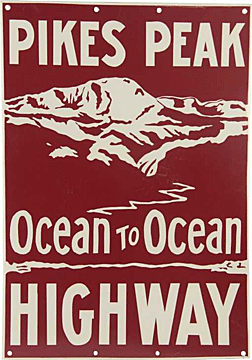 Unfortunately, Burma-Shave made their signs of wood as inexpensively as
possible, so few survive today. Vintage porcelain signs are more
durable. Collectors favor actual highway signs, as well as signs
designating scenic and named routes. Unfortunately, Burma-Shave made their signs of wood as inexpensively as
possible, so few survive today. Vintage porcelain signs are more
durable. Collectors favor actual highway signs, as well as signs
designating scenic and named routes.
For example, between World War I and the 1930s, brown rectangular
porcelain signs for the Pikes Peak Ocean To Ocean Highway could be seen
from the Atlantic to the Pacific Oceans. Black-and-white oval signs
depicting horses pulling a Conestoga wagon marked the overlap between
the growing U.S. highway system of the 1930s and the historic Santa Fe
Trail.
Other signs, erected in the 1920s by organizations such as the
California State Auto Association, helped drivers calculate distances to
their destinations. These yellow, diamond-shaped signs, often posted at
highway intersections, had mileages of landmarks to the left and right
highlighted with the help of black arrows.
Signs that indicated approved service stations are also of interest to
collectors. In the 1920s, for example, the Wisconsin Motorists
Association placed a dated sign every year on the sides of repair shops
it deemed good enough to be identified as an “Official Garage.” In fact,
signs were frequently the only assurance an out-of-town traveler had of
a business’s reputation.
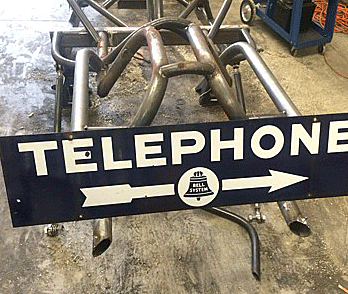 Other signs lured weary travelers from their vehicles. “Public
Telephone” signs with an arrow, letters, and symbol, dotted with
reflectors known as jewels could be found alongside roads across the
country. Once they had pulled over, travelers would use the stop as a
chance to fill up or find a restroom. Flanged or riveted porcelain signs
marked with symbols for men and women designated facilities. Other signs lured weary travelers from their vehicles. “Public
Telephone” signs with an arrow, letters, and symbol, dotted with
reflectors known as jewels could be found alongside roads across the
country. Once they had pulled over, travelers would use the stop as a
chance to fill up or find a restroom. Flanged or riveted porcelain signs
marked with symbols for men and women designated facilities.
Restroom signs ranged from simple rectangles with blue-and-white stripes
and alternating white-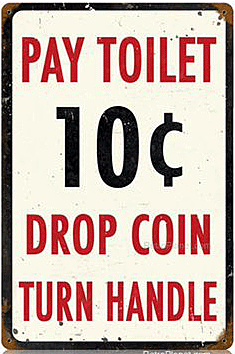 and blue letters to fancier signs with “Ladies”
and Men” written out in cursive and a silhouette of a top-hatted
gentleman and woman carrying a parasol to the side. Some restrooms signs
displayed perhaps too much detail about their virtues---“Ladies Rest
Room Equipped With Sanitary Seat Covers”—while others admonished
customers in advance not to be such slobs---“Help Keep This Place
Clean!” and blue letters to fancier signs with “Ladies”
and Men” written out in cursive and a silhouette of a top-hatted
gentleman and woman carrying a parasol to the side. Some restrooms signs
displayed perhaps too much detail about their virtues---“Ladies Rest
Room Equipped With Sanitary Seat Covers”—while others admonished
customers in advance not to be such slobs---“Help Keep This Place
Clean!”
One of the major types of signs created for public transportation
systems dealt with cleanliness, especially after World War I, when
tuberculosis and influenza were serious health problems.
Blue porcelain signs with white letters, designed to be placed inside
railway and trolley cars, got right to the point---“Spitting On The
Floor Of This Car Positively Prohibited By Order Of The Board Of
Health.” Signs from the 1930s in stations and platforms of the New York
City subway system even spelled out the punishment---“$500 Fine, A Year
In Prison, Or Both.”
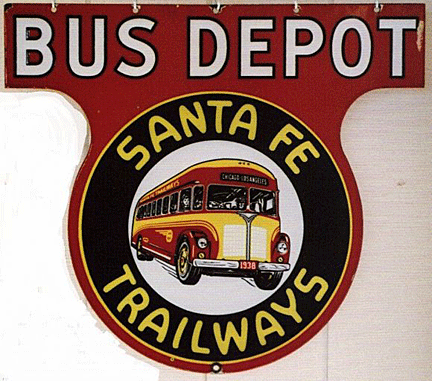 Collectors also prize signs for public and private transit systems,
whether it’s a green-and-white oval for the Pomona Bus Lines, an orange,
black, and white circle to mark the location of the depot for the Inland
Stage, or the myriad variations of signage created for Greyhound. Collectors also prize signs for public and private transit systems,
whether it’s a green-and-white oval for the Pomona Bus Lines, an orange,
black, and white circle to mark the location of the depot for the Inland
Stage, or the myriad variations of signage created for Greyhound.
Diecut signs in the 1920s and 1930s typically paired the word
“Greyhound,” an image of a bus, and a picture of the famous dog with the
name of the regional Greyhound affiliate, from Atlantic to Pacific. Oval
signs in the 1940s focused on the white purebred and the words
“Greyhound Lines” in orange.
Nostalgia plays a bit part in sign collecting. Often a sign a collector
will seek out a particular sign based on there they grew up or
vacationed. The Market Street Railway ran trains in San Francisco in the
1930s, and its diecut porcelain signs featured two shades of green, a
center section in lipstick red, and white letters, some of which proudly
proclaimed the company’s role in “Improving San Francisco.”
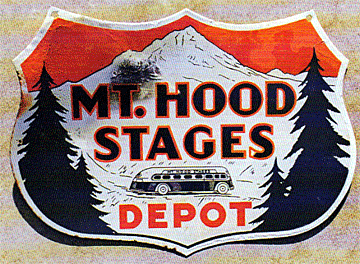 Sightseers and winter-sports enthusiasts near Portland, Oregon might
prefer a badge-shaped sign from the same era marking the location of the
depot for the Mt. Hood Stages. This handsome example of porcelain art
features the snow-caped mountain against an orange sky, an Art Deco
style bus below, and silhouetted trees on either side to frame the
composition. Sightseers and winter-sports enthusiasts near Portland, Oregon might
prefer a badge-shaped sign from the same era marking the location of the
depot for the Mt. Hood Stages. This handsome example of porcelain art
features the snow-caped mountain against an orange sky, an Art Deco
style bus below, and silhouetted trees on either side to frame the
composition.
Antique road signs that were built before 1950 are a hot commodity for
any antique memorabilia collector, and can range from stop or yield
signs, street signs, traffic marker signs, guide signs, highway signs,
rail road signs, speed limit signs and many more. Some collectors prefer
to collect antique road signs from a specific area or region, while
others like to collect antique road signs from a certain time period.
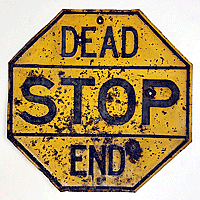 Older stop signs are typically yellow and black. The now common red and
white ones didn’t appear until the early 1950s. Older stop signs are typically yellow and black. The now common red and
white ones didn’t appear until the early 1950s.
Road sign collectors love early porcelain enamel road signs. These signs
originated in Germany but were very common in the U.S. between 1890 and
1950. Manufacturers used a base of heavy rolled iron, later coated with
colored powdered glass and fired in a kiln. Because of this process,
early porcelain enamel road signs tended to be more weather-resistant
and durable.
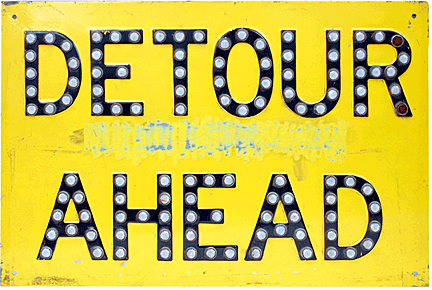 American road sign designers eventually started using silkscreens and a
steel base instead of iron to make these signs, and later started using
tin bases instead of steel when porcelain enamel became too expensive. American road sign designers eventually started using silkscreens and a
steel base instead of iron to make these signs, and later started using
tin bases instead of steel when porcelain enamel became too expensive.
Porcelain enamel road signs which were built between 1890 and 1950 are
considered to be the most expensive and rare, as well as antique rail
road signs. Antique road signs, or more specifically, antique speed
limit road signs which have jewels embedded inside of the numbers drive
up the value of the item. Collectors do not recommend restoring antique
road signs.
< Back
to Collectibles Archives Next
Article >
|
